Major RP Technologies
Stereolithography (SLA)
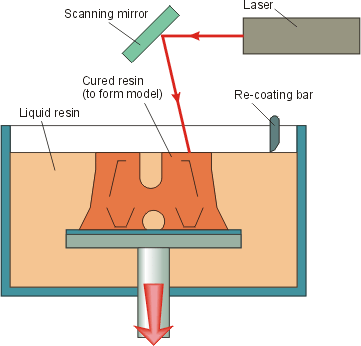
This method was the first RP method utilized by the industry.
The method employs an ultra-violet laser beam to cure liquid photo polymer in layers.
A platform starts one layer depth below the surface of the liquid, and the laser cures the first layer.
The edge of the layer is drawn out and then the interior is hatched to solidify inside the object.
Then the platform is lowered by one layer depth and the next layer is cured.
The process is repeating until the object is completed.
::to the top::.
Selective Laser Sintering (SLS)
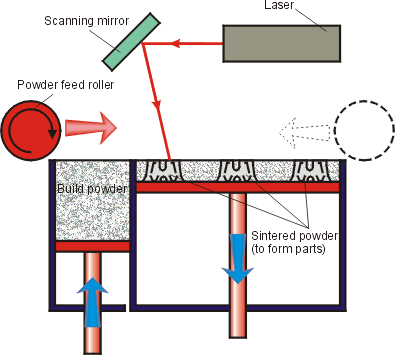
Systems of this kind use powdered material without any polymer binders rather than the liquid polymers used in stereolithography.
The laser melts selected areas of the powder and then lets it harden again, in this way the part is built up layer by layer,
the roller making a new flat coat of powder over the top after each layer is hardened. This process differs from other RP processes, such as stereolithography, in that it requires two state changes - solid to liquid to solid again - instead of just solidifying a liquid. Unlike processes using liquids, the part does not need to be supported as it is being built. After sintering, the part will sometimes need some post processing to smooth the surfaces after the unsintered powder is dusted off.
The main build materials being used are plastics, wax, pure metals or metal alloys such as special non-shrinking steel or bronze, and coated ceramics.
::to the top::.
Laminated Object Manufacturing (LOM)
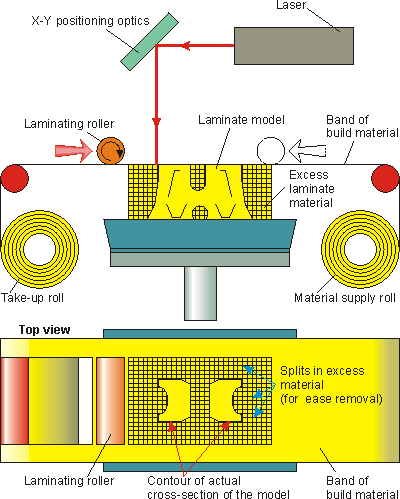
Laminated Object Manufacturing machine works by actually cutting the "slices" of the object out of a sheet of paper foil and then bonding them together. The foil comes off the material supply roll and the laser then cuts around the outline of the layer, it also hatches the foil around the edge so that this can be easily broken away when all of the layers have been bonded together. After the laser has cut out the top layer, a heated roller moves over the top of the foil to bond the layer to the rest of the object.
This process can also utilize plastic or even metallic foils as a build material, however so far no one of them has found wide application. Also known some modification of this technique, utilizing other means of cutting instead of laser such as knife or heated metallic wire.
::to the top::.
Fused Deposition Modeling (FMD)
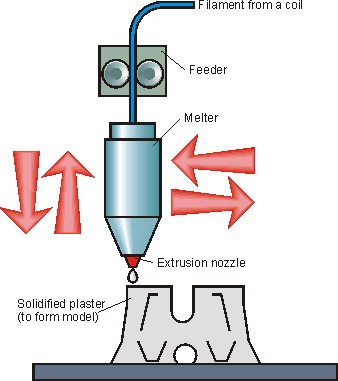
In this process a plastic filament is unwound from a coil and supplies material to an extrusion nozzle. The nozzle is heated to melt the plastic and has a mechanism, which allows the flow of the melted plastic to be turned on and off. The nozzle is mounted to a mechanical platform, which can be moved in both horizontal and vertical directions.
As the nozzle is moved over the table in the required geometry, it deposits a thin bead of extruded plastic to form each layer. The plastic hardens immediately after being squirted from the nozzle and bonds to the layer below. Several materials are available for the process including investment casting wax.
::to the top::.
3D Printing (3DP) or Selective Binding
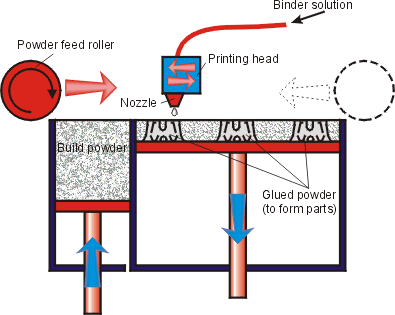
3D Printing or Selective Binding can be compared to SLS, the difference is that instead of laser beam, liquid binder is applied to bond the powder particles.
A 3D Printer is operated in the following sequence:
The Printer spreads a layer of powder from the feed box to cover the surface of the build platform.
The Printer then prints binder solution onto the loose powder, forming the first cross-section of the part. Where the binder is printed, the powder's particles are glued together. The remaining powder is loose and supports the part as it is being printed.
When the cross-section is complete, the build platform is lowered slightly, and a new layer of powder is spread over its surface. The process is repeated until the whole model is completed.
The build platform is raised and the loose powder is vacuumed away, revealing the completed part.
Currently, two major powder-binder systems for use with 3D printers are available. Each system provides specific advantages, and typically can be used interchangeably on 3D printers. The plaster-based powder delivers strength and detail. The starch-based powder delivers unrivaled speed at a very low cost, as well as suitability for investment casting.
::to the top::.
Solid Imaging (SI)
This technique is very similar to ink-jet printing technology and deposits layers of molten wax/polymer to form the shape of the part. Parts are built from the bottom layer similar to FDM and the overhanging features need to be provided with support structure in the parent material, which can be removed later. In contrast to one or two nozzles utilized in FDM-machines, this technique employs multi nozzles (up to 96 or even more) blocks.
::to the top::.
Laser Engineering Net Shape (LENS)

So far this is the most advanced process in terms of achieved mechanical properties of generated metallic parts among all commercialized processes based on layered manufacturing build principle.
The process uses a high power laser focused onto a substrate to create a molten puddle on the substrate surface. Metal powder is then injected into the melt pool to increase its volume. Powder ejection head moves back and forth in according to geometry of the first layer. After the first layer is completed, new layers are then built upon it until the entire object represented in the three-dimensional CAD model is reproduced. Employment of a substrate makes this process different from another ones, considered in this work.
This method can utilize wide range of metals and alloys (including super alloys) as a build material. Relatively high cost of operation and of produced parts on the on hand, and very high mechanical properties of generated by this method objects on the other, do not allow to consider the method as a plain RP technique, or as a means of visualization. This technology became efficient only in case of functional parts or tooling production.
::to the top::.





